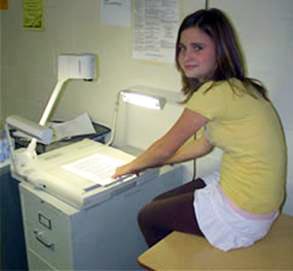|
 |
| Teachers.Net Gazette Vol.6 No.5 | May 2009 |
Subscribe for free home delivery |
|
The Document Camera: A Better Way to Present! Advancing classroom visual technology – a tool for all ages | ||
| by Joe Frisk Continued from page 1 May 1, 2009 |
||
 and Equipment I believe the greatest advantage of the document camera is the increased participation of students in lessons. Students beg for the opportunity to operate the camera! In my classroom, students run the camera and present materials while I lecture. I prepare lecture notes and graphics and divide them into sections by using line breaks in Word-produced documents. I give a student a quick instructional session before he or she presents the material by sliding the paper forward on the camera base, displaying one section of notes at a time. I allow the students to make mistakes as I teach them how to display material and avoid doing anything that might distract the audience, such as displaying their hands. A copy of the material is given to all students before presenting. When students get to college, they will know how to give professional presentations with this machine. Since students run the camera, they feel a sense of ownership in the equipment and lesson. They respect the technology and take care of it. In one class, students named my camera after a classmate who was fascinated with it. Students can display their work for all to see when a document camera is present. While teaching the Cornell note style, I allowed students to show their peers how they were taking notes so they could learn from each other. This versatility and spontaneity sets the document camera apart from other classroom tools such as PowerPoint and electronic boards. After modeling presentations, the teacher can put students to work creating group presentations using the camera. I believe retention increases when students teach each other.
Useful Across Disciplines Math teachers and students can work problems under the live camera lens. Placing math problems on paper and displaying them via the document camera works well when the white board is full. I found the classroom "smart board" to be clumsy for working out problems and school districts are putting them to that use. Electronic boards have a place in education but document cameras are more versatile and do not rely on a computer. If there is a networking or software problem, the smart board goes down with the computer. When subbing in geometry, a teacher forgot to give me access to his computer so I could run the lessons he had ready for his smart board. I had to track him down to gain computer access. The camera works well in the language arts classroom. English teachers display a lot of text, and the camera is best at showing text. I use size twenty font when putting together presentations, but the zoom feature allows most any font size to be easily read, even from the back of an auditorium or by vision-impaired students. Tiny font sizes often used for the captions of photos can be zoomed in on and easily read. With automatic focus and one-touch zoom, zooming in and out is not a distraction and is nearly instantaneous. In contrast, electronic boards I've used convert imported text files to pictures and blur the text. In social studies, the document camera can replace map sets. Students enjoy looking at wall-mounted maps and these should be provided, but when it comes to presenting maps in the classroom, nothing beats a document camera. I place maps into three-ring binders and organize them to coincide with my lessons. I can zoom in and out on various parts of a map and show detail that would otherwise be difficult for students to clearly see, especially those sitting in the back of the classroom, and I don't have to worry about getting in the way while displaying a map. I had a professor who would not use the camera, and his presentations suffered. He'd stand to one side of his map and get in the way as he pointed to various locations. To show a photo in a book, he would hold the book in his hands and walk around the classroom. I opined the document camera would help him display maps and photos. He stated he was too old to change. While I am licensed as a secondary school teacher, I have taught in the elementary schools and have found ways to use a document camera in teaching younger children. I believe this technology would be a boon to teachers willing to give it a try, as children enjoy visuals and are not afraid of new technologies. Document cameras are simple for youngsters to operate and are also tough enough to stand up to little hands.
| ||
|


 Joe Frisk is certified in 5-12 Social Studies with a Master of Arts in Teaching degree from Minnesota State, Mankato. He taught part-time as a substitute in the Austin, Minnesota public school district from 2002-2008 and has recently worked in the mental health profession.
Joe Frisk is certified in 5-12 Social Studies with a Master of Arts in Teaching degree from Minnesota State, Mankato. He taught part-time as a substitute in the Austin, Minnesota public school district from 2002-2008 and has recently worked in the mental health profession.